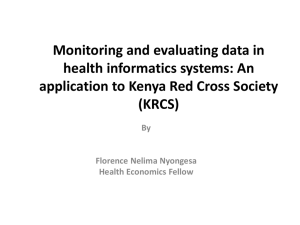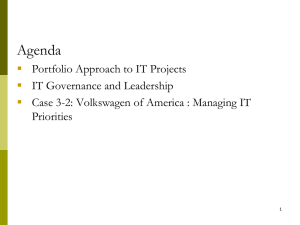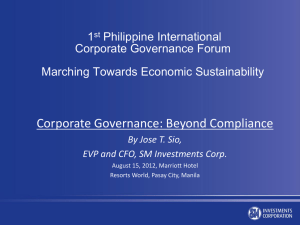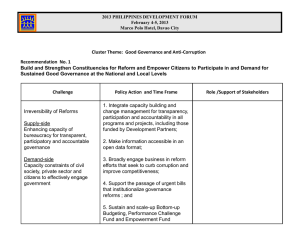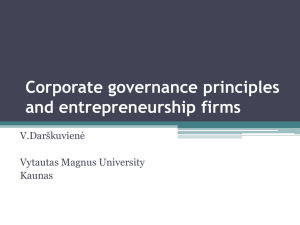Good governance - Rotary Club of Westlands, Nairobi
advertisement
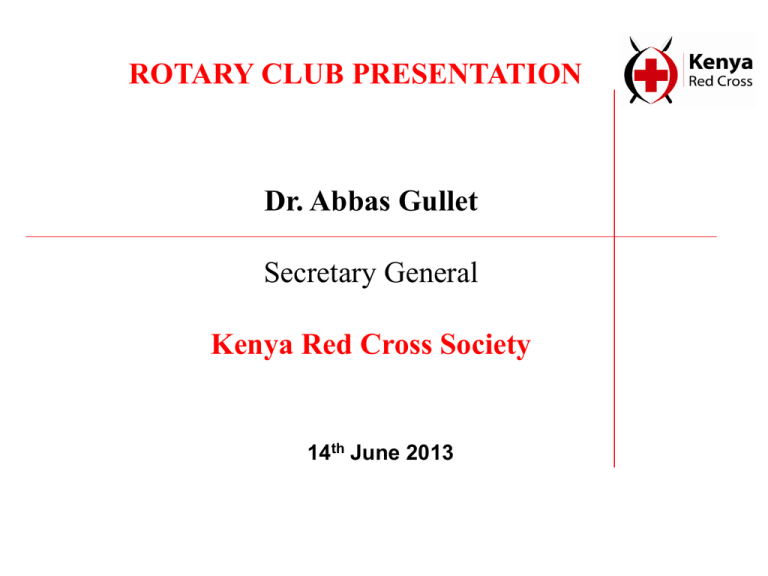
ROTARY CLUB PRESENTATION Dr. Abbas Gullet Secretary General Kenya Red Cross Society 14th June 2013 Establishing Institutional Resilience through Good Governance : The Case Study of Kenya Red Cross Introduction Current global quest for so-called “good governance” in all types of organizations including humanitarian entities such as red cross national societies An organization has good governance when it has an internal system of checks and balances to ensure that the public interest is served. An explicit governance structure is the first step in establishing a stable and reliable framework for accountability and good governance Checklists include key concepts in governance are: Accountability, efficiency, effectiveness, predictability, sound financial management, fighting corruption and transparency. Key Issues in good governance organisational aspects • Are there both executive/management and governance structures? • Are they separated? • Is the oversight real, not only symbolic? • Is it clear who makes what, who is responsible for what? • Are staff aware of and does it respect the above mentioned? financial aspects and transparency • Are there effective budgeting and fiscal systems at place? • Is there an effective oversight over financial issues? • Is the national Society transparent transparent? Key Challenges facing national societies in Africa Exposed GOVERNANCE FAILURES that leads to lack of accountability arrangements which constitutes a breeding ground for Corruption and wanton theft Concentration of power- that lack of seperation of functions Lack of democracy in the selection of the governance teams. Lack of internal control systems such as audits, proper fiscal policies. Compromised and poorly skilled management teams Why is Good Governance Critical Economic sustainability: With good governance NSs become independent in the long run. Diversification of income base with an increase in the faith of the donors Ensure effectiveness in an increasingly complex environment Corruption and lack of accountability jeopardises important sociocultural values associated with humanitarian work Dysfunctional national societies have huge impact on society Evolution of management of public bodies in Africa such as ANSs The old public management bureacratic style, ineffective management, lack of transparency ↓ The new public management market-driven approach, effective management,proper boards, separation of functions between board and management ↓ Good governance new syntesis and maturity - aimed to reach sustainable growth and efficiency , as well as beneficiary satisfaction. Dual Governance Structure It is based on distinction between organizational entities that is governance and management, and the distribution of decision-making between them. This dual governance structure is the key to maintaining good governance This arrangement helps retrain and moderate the control of any one person or group of persons to ensure the organizational resources are well managed. Complete separation is essential. For example even when the management teams/staff understand the organization very well, presence of staff members in governance teams blurs the distinction and leads to conflict of interest. Complete requirement for avoiding conflict of interest i.e through declarations of wealth, conflict of interest declarations/policy Board/Governance as Principal governance Body There should be a governing body that wields constant and consistent oversight and decision-making authority. Usually a separate body that exercises governance functions such as setting policies and strategies. The board should represent the interest of all the stakeholders. The collective leadership of the board should facilitate and organization to be focused on the mission of the organization and resist special agendas, interests of specific persons. It is the collective decision making of the board as a team with multiple experiences and talents that helps the board function effectively It is therefore critical to have a board constituting multiple experiences and professionals. Good Governance and Internal Controls Internal controls promotes efficiency and integrity Among these controls include professional accounting standards, seperational of transactional responsibilities and annual audits. The internal controls should be reviewed periodically and to ensure that they are being observed. Central internal control is annual audits. This speaks loudly about financial reliability. Experience of the Kenya Red Cross The KRCS Journey of 8 Years KRCS was mismanaged and bankrupt & equated to a leaking bucket. Was in debt of $500,000 & rated as one of the most corrupt NSs. A problem of leadership, governance & lack of Accountability. Was least responsive to National emergencies. KRCS HQ 9 years ago Limited partners & donors due to lack of credibility & bad image. There was a problem with programmes. Lack of professionals with overstaffing & demotivated staff. The Society took a decision to change things KRCS HQ, Nairobi in 2013. Change Movement Audited our operational systems using SGS audits to establish key gaps and weaknesses. Establishment of a new board-getting right people in, and the wrong ones off the bus. Included co-opting professionals and experts in various fields such legal, health, finance, management. Put in place appropriate policies including in the areas of finance, procurement, risk management, human resource. Instituted regular audits. Reviewed legal base to provide for separation of powers between management and governance. Put in place mechanisms for election of board members through regular periods. How we did it at KRCS 2005- SGS Auditing Restructuring, downsizing. and hiring professionals. Training for Governance & staff. Development through strategic plans that are carefully implemented. Training session for KRCS staff KRCS Governance a meeting Best Practices from KRCS Walking the talk by adhering to our vision of being the most effective & most trusted & self-sustaining humanitarian organization in Kenya. Transparency at all levels. All Board & SMT signed oath of office Declaration of assets & wealth and conflict of no interest. Signed code of conduct. Elections every three years Board vetted by and elections conducted IEBC before elections Annual audits at all levels of society. KRCS Elections conducted by IIEBC in 2010. KRCS Today KRCS is the lead humanitarian agency of choice for Government & other stakeholders. Responds to disasters in the shortest time possible through 64 branches, 8 regions & HQ networks. NFIs for up to 30,000 families. Was appointed the lead humanitarian agency in Kenya. KRCS volunteers respond to an accident KRCS warehouse with prepositioned stock. Food Security projects Investing & Increase in Value Bold step in investments and property development, among them, the Red Court hotels and E-Plus ambulances. Funds now generated from KRCS business activities ploughed back to the humanitarian work. Business arm of KRCS run by professionals. E-Plus state-of-art ambulances The Boma Hotel in Nairobi, fully owned by KRCS. Red Court & Boma Hotels Red Court Hotel, Eldoret under construction Red Court Hotel in Nyeri. Red Court Hotel conference complex, Nairobi. The Boma Hotel, Nairobi KRCS SUCCESS - RECOGNITION First non-profit organisation to be awarded Super brands status, 2007/2008, in recognition of its brand. Road Safety Award 2012 Governance Award 2012 for Best Humanitarian Organisation KRCS has attained a special status; awarded the Millennium Development Goals (MDGs) 2010, 2011 and 2012 Champion of the Year: Eradication of extreme poverty & Malaria Control . KRCS team receives MDGs Award 2010. Awarded by Public Relations Award in 2009, 2010 and 2011 for PR Excellence. Principle Recipient of Round 10 Global Fund. Refugee operations in partnership with UNHCR. Above: HMM Award & Below: Award in PR excellence. Future Plans To remain true to the humanitarian mandate despite an investment mindset; first in, last out. Look for more business ventures for financial sustainability. Move forward through new strategy anchored on three pillars: INTERNATIONAL CENTRE FOR HUMANITARIAN AFFAIRS Proactively alleviating human suffering through generating and imparting knowledge RESEARCH & INNOVATION •Identifying Evolving Needs •Conducting & Disseminating Research •Preserving & Sharing Knowledge KNOWLEDGE GENERATION & TRAINING •Generating Knowledge •Disseminating knowledge •Filling Skill Gaps •Building Capacity POLICY & ADVOCACY •Informing Policy & Implementation •Influencing Stakeholders •Governance Management MAJOR AREAS OF INTEREST: Disaster Management, Food Security, Peace Negotiations &Conflict Management, Health, Water and Sanitation, Malaria, HIV/ AIDS, Emergency Medical Support, Community Outreach & Empowerment, Volunteerism... THE END THANK YOU.
